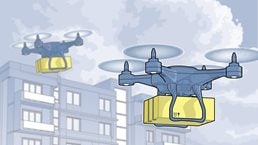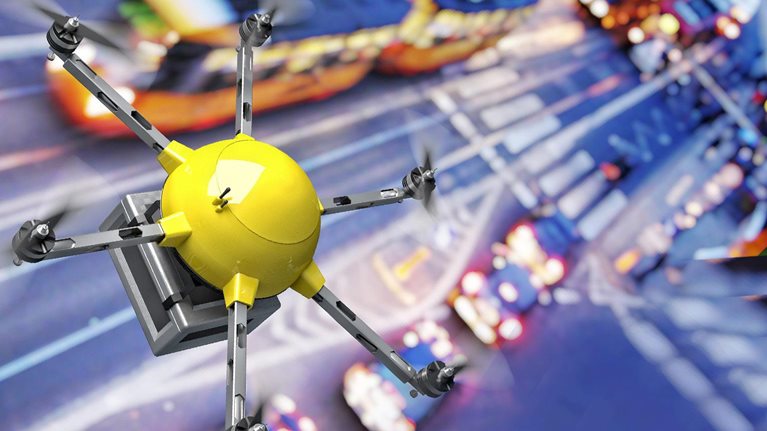Most people think of a drone, also known as an unmanned aerial system (UAS), as a sophisticated military technology or a hobbyist’s tool for capturing images of foliage, sporting events, and cityscapes. But businesses across industries realize that drones have multiple commercial applications, some of which go beyond basic surveillance, photography, or videos, and they are already using them to transform daily work in some industries. Insurance companies are using drones to inspect damaged assets, for instance, and farmers are sending them to monitor crops and collect soil data. Even more dramatic changes could be in store as innovators explore new uses, including drone-delivery services for retail stores and air taxis for commuters.
Stay current on your favorite topics
The United States has been a particularly strong source of commercial growth, with the value of drone activity rising from $40 million in 2012 to about $1 billion in 2017.1 By 2026, we estimate that commercial drones—both corporate and consumer applications—will have an annual impact of $31 billion to $46 billion on the country’s GDP.2 Developments within the United States could thus signal how commercial drone usage and investment will proceed in other markets. (This article focuses on the growing commercial market, as the military-, security-, and intelligence-applications markets are already advanced.)
As with any new industry, the UAS market could take some unexpected turns. Investment is soaring, but many companies are directing their funds to untested applications. Take air taxis, which are drawing much press attention. These technologies are still in early development, and public acceptance is uncertain. Other hurdles involve regulatory approval and infrastructure. Government officials will not rubber-stamp a proposal for unpiloted flights, nor will cities automatically invest in infrastructure for drone takeoffs, landings, and storage. The situation with air taxis may be extreme, but similar issues could arise with any UAS application.
Although some of the most innovative drone applications may take years to develop, stakeholders—government officials, investors, regulators, members of the UAS industry, and corporate adopters—must understand how the landscape is evolving and begin refining their UAS strategies now if they want to branch beyond their current uses and capture additional value. This article addresses three topics that may help them sort through the current uncertainty:
- UAS value. What is the real potential of the market? Which segments of the value chain are attracting investment, and are there areas of untapped opportunity?
- Factors influencing the UAS market. What are the forces that will determine how the UAS market evolves? What technologies provide growth opportunities, and how can companies proactively shape demand?
- Initial strategic considerations. How can UAS stakeholders capture or create value? What issues need their attention now?
Understanding the UAS market
Originally viewed as a military tool, drones have established a presence in the corporate world over the past five years. Some big tech companies are investigating drone-delivery services, while others are exploring whether specially equipped drones can supply Internet connections in remote areas. Some players are also investigating industry-specific solutions. For instance, construction-technology company Veerum uses drones and 3-D imaging to create “digital twins” of projects, accurate down to the millimeter, allowing companies to validate their work against 3-D models.
Would you like to learn more about our Capital Projects & Infrastructure Practice?
Although the tech giants tend to grab headlines with their drone initiatives, start-ups actually drive most UAS activity; more than 300 have entered the space since 2000. These companies typically focus on hardware, support services, or operations (Exhibit 1). The latter is a broad category that includes software and services related to navigation, unmanned traffic management (UTM), the mitigation of threats related to unmanned aerial vehicles (UAVs), and the construction and maintenance of UAS-related infrastructure, such as vertiports to accommodate drones that take off and land vertically.

Start-ups have attracted more than $3 billion in funding to explore new UAS applications, industries, and geographies (Exhibit 2).3 OEMs have received almost half that amount (about $1.4 billion), and other big investments have gone to companies specializing in navigation and UTM ($371 million) or data management ($328 million). Businesses that compete in multiple segments have also had a strong showing, receiving $356 million in funding.

As the market matures, more value will migrate to software, especially for turnkey solutions that improve UAS operations by enhancing detect-and-avoid systems, enabling analytics, and assisting with navigation in areas where drones cannot rely on a GPS signal. Companies would also value turnkey software solutions that support autonomous flight and integrate air-traffic control of drones and planes.
Popular UAS applications
The most mature applications—and the only ones where drones are widely applied in either the corporate or the consumer sector—involve short-range surveillance and associated photographs or videos (Exhibit 3). Drones capable of long-range surveillance—defined as beyond the visual line of sight—may enter the market over the next few years.

Some drones that assist with operations are on the market, and this category is still growing. They complete tasks normally counted among the “three Ds”—dull, dirty, or dangerous, such as window washing. Drones have also found a place in entertainment and advertising, either pulling banners or putting on light shows.
Even more intriguing are the applications that are still under development or in their early stages, including drones equipped to emit radio or video signals or other forms of bandwidth for connectivity. These might be most useful for extending connectivity to remote areas or increasing it when demand surges. Drones for helping the movement of objects are being used on a small scale, with UAS delivery services expected to become available in the next five to ten years. More radical transport uses—say, drone-enabled flights—would require a much longer development and approval timeline.
The factors influencing the UAS market
The value of commercial drone manufacturing and related service activity in the United States could rise to $8 billion to $20 billion by 2026.4 The future of this industry is still up for debate in many ways, since it depends on five factors that will dictate its value and influence (Exhibit 4). First, and perhaps most vital, is the issue of public acceptance. Several surveys have demonstrated that people have reservations about drones; in a 2016 poll, only 44 percent of US respondents supported their use for delivery services.5 Attitudes may soften as drones become more common, but the industry has to build a lot of confidence before people will accept thousands of them flying overhead or board UAS air taxis.

As with any industry, economic drivers will also shape demand. In the United States, companies may unlock the greatest value from drones that streamline operations and facilitate automation rather than more headline-grabbing applications, like drone delivery and transport. This is part of a broader move to automate and digitize operations, and the best companies will keep such economic drivers at the forefront as they develop their UAS strategy. Although these uses may not attract as much interest as those related to transport and delivery, they are more attainable and potentially more lucrative, at least over the short term.

Read our latest thinking on drone infrastructure
Finally, there are some practical factors related to technology, regulation, and infrastructure, and they will largely determine which drone applications are feasible. We looked at each of these areas in detail to determine what needs to happen before companies can unlock maximum value from drones.
Technological capabilities
Drones rely on a number of sophisticated technologies, but many of these are still under development. Until we see improvement in the following areas, many of the most innovative UAS applications will remain at the concept or pilot stage, including those related to drone delivery and transport.
- Autonomous flight. While a few drones can already fly without a user directing their path, this technology is still emerging. Over the next five years, system-failure responses, dynamic routing, and handoffs between human and machine controllers should improve. With greater autonomous control, companies will be able to pursue uses that are now elusive, such as the repeated and unpiloted surveillance of pipelines, mines, and construction projects.
- Battery performance. Rapid improvements in battery technology will also unlock new value from drones. The energy density of lithium-ion batteries is improving by 5 to 8 percent every year, and their lifespan is expected to double by 2025.6 These improvements will allow commercial drones to fly for more than an hour without recharging, enabling many new uses.
- Detect-and-avoid technologies. These systems, which help drones avoid collisions and obstacles, are still in development, with strong solutions expected to emerge by 2025. (Drones that hobbyists use have some detect-and-avoid systems, but they are relatively unsophisticated.)
- Integrated air-traffic-management (ATM) systems. Drones currently fly below the height of commercial aircraft because of the collision potential. UTM solutions that can track drones and communicate with air-traffic-control systems for typical aircraft are not expected to materialize for more than a decade, making high-altitude flights impossible until that time.
- Location technologies. Drones must be able to identify their location even in areas where GPS signals are limited or degraded, such as densely built cities and remote locations. Like air-traffic-management integration, the widespread rollout of a GPS alternative is more than ten years in the future.
Regulation
Most countries are now grappling with regulatory issues related to drones, as they would with any innovation that has implications for public safety. The United States, for instance, now has a Drone Advisory Committee, which includes regulators and industry stakeholders tasked with integrating drones into the national airspace. Regulators are charged with thoroughly evaluating the implications of new UAS uses, including potential safety issues, before they reach the market. That means the regulatory process and timeline will ultimately determine when many UAS applications become viable.
Within the United States, regulators might develop a comprehensive suite of regulations that covers three areas: UAS vehicles, operations, and operators (Exhibit 5). For instance, regulators could consider whether drones can operate beyond the visual line of sight, with a positive decision enabling more uses, such as the delivery of medications to patients in remote areas. Based on safety analyses, regulators could also issue new guidelines related to autonomous flight, weight and altitude restrictions, and other areas. Such regulations might remove additional roadblocks for drones.

Infrastructure
Most current UAS applications have modest infrastructure requirements. A drone to map construction sites might simply land on an empty patch of dirt and recharge its battery using the same power outlet other devices do. But as UAS sophistication increases, so will infrastructure requirements for charging stations, landing facilities, and other assets. Such issues may not seem like a pressing concern given current infrastructure needs, but private investors and public officials are aware that the future UAS landscape may look very different. Some have already begun constructing supporting infrastructure or acquiring air rights, since first movers can claim prime locations.
While requirements will vary with every application, robust UTM systems are essential to enable safe, low-altitude operations within the national airspace. The beacons and other infrastructure are not yet in place for such systems. (As noted earlier, applications that require high-altitude flights will not be viable until UTM systems can communicate with air-traffic-control systems for commercial aircraft.) All UAS applications also require counter-UAV solutions to detect and safely disable unauthorized vehicles in the airspace.
In addition to these universal requirements, most future applications have other significant infrastructure needs. Consider a few facilities that companies, governments, or fleet operators might need to create to support transport and delivery:
- vertiports with multiple takeoff and landing pads for drones transporting people and cargo; single vertistops with one landing pad may suffice for smaller stations
- service centers where air taxis and other transport vehicles can be stored, inspected, and repaired
- distribution hubs to load and receive goods from drones
- charging stations for UAS batteries
- receiving stations (such as lockers, boxes, or platforms) to receive objects delivered by UAS
When stakeholders research such infrastructure costs—and many are now in the process of doing so—they may find that some of their most ambitious plans are unfeasible or cost prohibitive.
Public versus private funding. As the UAS market increases, industry and government leaders must determine the right mix of public and private investment—but the answer may vary depending on the proposed application. For instance, some vertiports may serve a handful of niche businesses and thus provide minimal public benefits. In such cases, it might be difficult to argue that the government should play a role in development, operations, and maintenance. But the opposite might be true for a vertiport used in a transport system where any citizen could purchase a ticket or for one used by emergency responders.
Funding decisions that are made today will have major repercussions down the line. In locations where the government does not have a stake in UAS infrastructure, businesses could create a closed system of vertiports or other assets for their exclusive use. They could then refuse access to other companies or force them to pay a tariff, creating a monopoly. The potential for this scenario could give governments an incentive to create their own infrastructure or purchase a partial stake. Alternatively, government regulators could opt to play a larger role in ownership and access rights for privately owned UAS-infrastructure systems.
First steps in forging a UAS strategy
Success in the UAS world requires a balance of optimism and realism, action and patience, confidence and restraint. The following considerations can help stakeholders begin building the right UAS strategy:
Members of the UAS industry
While it may be tempting to focus on UAS applications that are making headlines, industry players such as manufacturers and software providers might achieve better returns through less flashy investments, such as drones that help companies automate manual tasks. OEMs and component providers should also determine which areas of the value chain are already crowded with competitors, since they may achieve better returns elsewhere. OEMs should try to determine what drone elements they would like to build and what they would like to outsource, as well.

Navigating the digital future: The disruption of capital projects
Corporate UAS adopters
Companies have a lot of options when it comes to drones and may be tempted to pursue multiple applications. But these are not just fun toys—they often require big investments, and they need to be fully integrated into work processes to produce a significant impact. That’s why a winning approach often involves focusing on a limited number of applications that solve critical problems or deliver a real bottom-line impact. Winning companies should also consider how they will use drone data as they design their initial strategies. For instance, UAS images may show how remote physical assets typically deteriorate, allowing companies to develop better predictive-maintenance schedules.
Investors
Drones sometimes require more time to deliver value than typical investments do, so investors need to think about the long game as they develop their strategies. They may also benefit from focusing on areas of the UAS value chain that have received relatively little investment, such as infrastructure, or drone-related services.
Regulators
As regulators begin to shape guidelines, they could build their understanding of the evolving UAS market by collaborating with a broad range of stakeholders, ranging from traditional aviation leaders to drone specialists to end users in the private sector. This outreach will give them a better perspective on potential UAS uses, product development, and technological or infrastructure constraints.
State- and local-government officials
At all levels, officials should consider the government’s role in the UAS world, including the use of public funds for infrastructure. The plans and budgets that they develop today should consider the potential role that drones will play in new mobility models over the next 5-, 10- and 15-year horizons, as well as the associated infrastructure needs. During these early days, officials might benefit by investigating creative partnerships with private companies to design and fund critical projects, such as vertiport construction.
Although drone-enabled deliveries, air taxis, and many other UAS innovations will not be widely available for years, they could rapidly transform society when they do. That gives all industry stakeholders a large impetus to identify roadblocks and realistically consider potential applications now. Within the United States, where the estimated GDP impact is expected to reach $31 billion to $46 billion by 2026, the stakes are particularly high. Some of the best opportunities may arise in areas that address current business problems, such as low productivity, rather than more transformative applications, like air taxis, or areas that are only just beginning to generate interest, like infrastructure. Can government officials, regulators, innovators, and other stakeholders come up with solutions that will make the most innovative UAS applications feasible and drive demand? If the answer is yes, the next decade might see the introduction of a new technology that could be as disruptive as the advent of automobiles.


